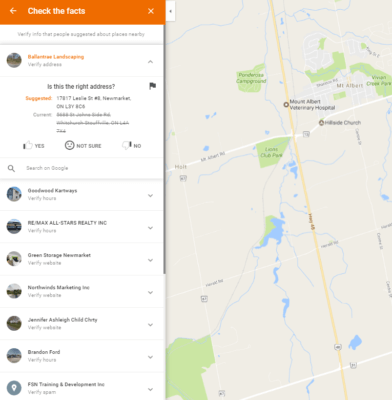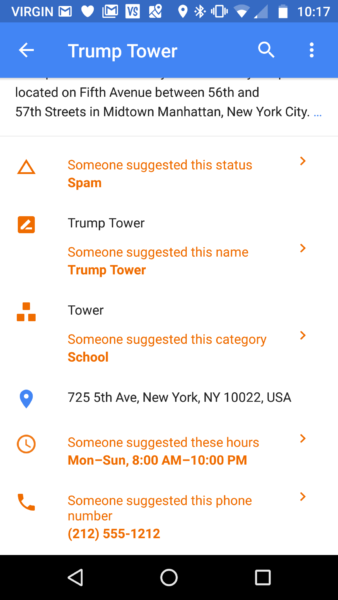
We all know that Google is constantly launching updates to their products (over 1,600 last year), and some of these changes are well covered and some slip by unnoticed. I have quietly been keeping track of some of the major changes I’ve noticed so far this year that would impact those of us who work in Local SEO and wanted to share my observations.
1. Google removes permanently closed listings from the Local Finder
If you look at the picture from my article last year about permanently closed listings, you’ll see that there used to be tons of “permanently closed” listings ranking in the Local Finder. They would typically show up at the end of the list (after the open ones), and if you edited a ranking listing to make it appear permanently closed, it would instantly drop to the back of the list.

I haven’t seen a single “permanently closed” listing in the Local Finder in months. This is mostly a good thing, since they aren’t overly useful for users.
The “permanently closed” label is problematic for local SEOs in a couple of scenarios. The first would be for businesses that have practitioners. These are the industries that are most likely to have “permanently closed” listings floating out there that they don’t know about for their practitioners. They are now harder to find, but customers could still be seeing them while searching on Google.
Tip: Search for all your existing and former practitioners on Google by name + city and make sure you don’t have any of these out there.
The second problematic scenario would be when spammers start marking competitors as “permanently closed” to make them disappear. You won’t get any type of notification from Google when this happens to your business (Thanks, Google!) unless you visit your Google My Business dashboard daily.
Tip: Since not everyone has time to do that, my suggestion would be to utilize a ranking tracker that also sends you alerts when they notice changes on your listing, like BrightLocal does.
2. Google removes the ability to access the classic version of Google Plus
Google came out with the new version of Google Plus back in 2015, but up until a couple of months ago, they still kept the classic version accessible — and it was the version that Google cached in their search results.
Why does this matter for local SEOs? The classic version had all the Name, Address, Phone Number (NAP) data on it that we loved so much, and the new version gives you none of this info. Many of us used the site:plus.google.com search to find duplicate listings for clients, and this function no longer works, since the cached version of Google Plus has no phone number, no address and no reviews.
Tip: Unless you’re using Google Plus for posts that get lots of engagement, you don’t have much else to do over there, since it’s now almost completely divorced from Google My Business. Posting random links to your blog articles won’t help you unless they get shares, +1s or comments.
3. Google launches a platform for reviewing edits to business listings on Google Maps on Desktop
Since MapMaker shut down, lots of people are under the impression that reviewing edits to business listings is no longer possible. Google has had the ability to review edits on the Google Maps app for quite some time, but since those of us in the local SEO industry rarely sit around doing client work on our phones, lots of people don’t realize this is possible. In March, Google also launched a “Check the Facts” feature on Desktop for Local Guides. This is a very simplified version of editing and isn’t really comparable to what we used to have on MapMaker, but it does allow for users to approve or deny each other’s edits to business listings. When this first launched, it was only available to Local Guides who were a Level 5 but rolled out to all Local Guides levels a few weeks later. 
4. Google removes pending edits for a listing’s status from showing up on the Google Maps app
I outlined in this article how spammers were attacking legit business listings by reporting their listings as spam just to get the pending status to show up on their listing on mobile. Indeed, these spammers shifted their focus to Trump Tower at one point, and searching for it on the Google Maps app produced the following listing:

Google removed pending edits for a listing’s status shortly after I wrote that article, so now if someone reports you as spam, you don’t have to worry unless the edit actually publishes.
5. Google rolls out the Snack Pack to more industries in the USA
Different from the 3-pack, the “Snack Pack” refers to the local layout that that is missing the links to the business website or driving directions; instead of seeing these (useful) buttons, you get an image.
For some reason, Google decided earlier this year that all of us who search on Google would love to see pictures of bugs when searching for pest control instead of a website that would tell us more about the company we’re potentially hiring.

Mike Blumenthal pointed out that in addition to pest control, jewelers and sporting goods stores also now have this layout.
[Read the full article on Search Engine Land.]
Some opinions expressed in this article may be those of a guest author and not necessarily Marketing Land. Staff authors are listed here.
About The Author

